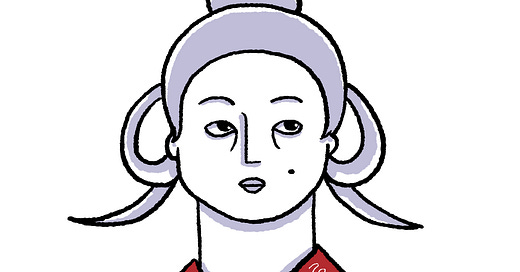From the beginning, when I got the idea for this comic 8 months ago – more on that in a later post – I wanted to be as inclusive as possible, to illustrate womanhood in its diverse and evolving spectrum across history. But I quickly came across a moral crossroads.
You might say that I’m a modern migratory Homo sapiens – I was born in the Transylvanian Mountains and now live on the banks of the River Thames. When I moved to London, I first experienced cultural displacement, and then, slowly and over a few years, cultural assimilation. And that was between what you could call relatively similar cultures.
This experience made me think that I’d be overstepping if I started to talk about and draw cultures I’ve never experienced – Asian, African, or South American, for example. Yes, I’ve met and spoken with people from these regions, and I actually live in an area of London with a strong South American community – but that’s not the same! How can I, a white European, speak for the experiences of a Black woman in Africa? It didn’t feel right.
So, when I started working out my characters, I based them all on a historic version of myself – white, European – thinking that, down the line, I would invite experts and historians to collaborate on various episodes and shed light on the experience of womanhood in different cultures.
When I’d completed the first few pages of the comic and shared them with a chosen few for an initial reaction, one of the first pieces of feedback I received was from a particular friend: “Why are they all European?” I explained my reasoning, and their reply was: “So? You didn’t live in the Stone Age either!”
Yes. True. But is it right? As I said, I was on the fence about this for a long time.
Then, because I kept reading and learning about the experience of being a woman across time, I discovered this: that society in Ancient and Imperial China was highly patriarchal, with strict gender roles. Women were expected to obey their fathers, then their husbands, and later their sons after their husband’s death – to the point that women were often identified by their relationship to male heirs, rather than by personal given names.
This, of course, made me angry. But while that’s a gut reaction, it’s not necessarily constructive.
I can’t change the past, and I know that things are different in modern Chinese society. What I can do is help fill in the picture of herstory. Those societal norms are part of the wider story, and I can’t ignore them. Ultimately, this comic aims to paint a picture that has been left blank for far too long. I can’t speak for another culture, but I can share what I learn, and build and offer a space for those who can speak for those cultures.
That being said, I’d like to add a caveat. I am, first and foremost, an illustrator – with a historian’s heart and a curious mind – and while I will do my best to research thoroughly every time, there will be mistakes, and there will be creative licence. Please don’t take these episodes as definitive historical proof or even as accurate historical representations. This comic is about celebrating curiosity and womanhood.
Even with this approach, choosing just 12 women to represent is tough and pretty much impossible to mention everyone and everything. Still, I move forward with the belief that some representation is better than none, and with the hope that, by stepping forward, I leave a door open for those who come after me.
P.S. If you’re a historian or know stories of women that need to be told, I’d love to chat!





